
Land Administration Building is a heritage-listed former government building at 142 George Street, Brisbane City, City of Brisbane, Queensland, Australia. It was designed by Thomas Pye and built from 1899 to 1905 by Arthur Midson for the Queensland Government. It was also known as the Executive Building or (now) the Old Executive Building. It was added to the Queensland Heritage Register on 21 October 1992.

The Masonic Temple is a heritage-listed masonic temple at 311 Ann Street, Brisbane City, City of Brisbane, Queensland, Australia. It was designed by Lange Leopold Powell of Atkinson, Powell and Conrad and was built from 1928 to 1930 by George Alexander Stronach & Son. It is also known as the Masonic Memorial Temple. It was added to the Queensland Heritage Register on 21 October 1992.

Baroona Hall is a heritage-listed community hall at 15-17 Caxton Street, Petrie Terrace, City of Brisbane, Queensland, Australia. It was designed by Richard Gailey and built from 1883 to 1884 by James Stuart Martin. It is also known as Caxton Street Hall, Josephsons Clothing Factory, and United Brothers Lodge. It was added to the Queensland Heritage Register on 21 October 1992.

Family Services Building is a heritage-listed office building at 171 George Street, Brisbane City, City of Brisbane, Queensland, Australia. It was designed by George Gerald Hutton and built from 1914 to 1922. It is also known as former Administration Building, Queensland Government Insurance Building, and Queensland Government Savings Bank. It was added to the Queensland Heritage Register on 21 October 1992.
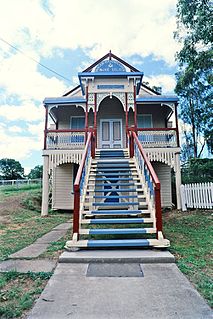
Yangan Masonic Hall is a heritage-listed masonic hall at 36 King Street, Yangan, Southern Downs Region, Queensland, Australia. It was built from 1898 to 1957. It is also known as Yangan Masonic Temple and was formerly the Yangan School of Arts. It was added to the Queensland Heritage Register on 21 October 1992.

Our Lady of Assumption Convent is a heritage-listed former Roman Catholic convent at 8 Locke Street, Warwick, Southern Downs Region, Queensland, Australia. It was designed by Simkin & Ibler and built from 1891 to 1914. It is also known as Assumption College, Cloisters, and Sophia College. It was added to the Queensland Heritage Register on 21 October 1992.

Warwick Town Hall is a heritage-listed town hall at 72 Palmerin Street, Warwick, Southern Downs Region, Queensland, Australia. It was built from 1887 to 1917. It is also known as Footballers Memorial. It was added to the Queensland Heritage Register on 21 October 1992.
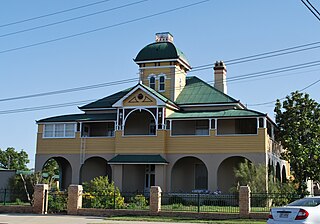
St Mary's Presbytery is a heritage-listed Roman Catholic presbytery of St Mary's Roman Catholic Church at 142 Palmerin Street, Warwick, Southern Downs Region, Queensland, Australia. It was designed by Wallace & Gibson and built from 1885 to 1887 by John McCulloch. It is also known as Father JJ Horan's private residence. It was added to the Queensland Heritage Register on 31 July 2008.

Uniting Church Central Memorial Hall is a heritage-listed church hall at 86 East Street, Ipswich, City of Ipswich, Queensland, Australia. It was designed by George Brockwell Gill and built from 1895 to 1895 by W Betts. It is also known as Congregational Sunday School. It was added to the Queensland Heritage Register on 9 July 1993.

Cooroora Masonic Temple is a heritage-listed community hall at 9 Station Street, Pomona, Shire of Noosa, Queensland, Australia. It was built in 1923. It was added to the Queensland Heritage Register on 12 December 2003.
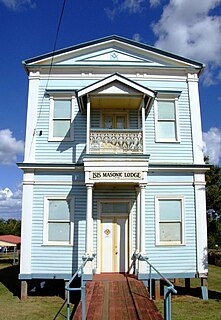
Isis Masonic Lodge is a heritage-listed masonic temple at 18 Macrossan Street, Childers, Bundaberg Region, Queensland, Australia. It was designed by F H Faircloth and built from 1897 to 1909. It is also known as Corinthian Lodge. It was added to the Queensland Heritage Register on 28 April 2000.

Mount Morgan Masonic Temple is a heritage-listed masonic temple at 2 Gordon Street, Mount Morgan, Rockhampton Region, Queensland, Australia. It was designed by Eaton & Bates and built in 1903 by Newman Brothers. It was added to the Queensland Heritage Register on 21 October 1992.

Block A of the Rockhampton Technical College is a heritage-listed technical college building at Bolsover Street, Rockhampton City, Rockhampton, Rockhampton Region, Queensland, Australia. It was designed by Thomas Pye and built in 1914. It is also known as Rockhampton College of T.A.F.E. and Rockhampton State High School and Technical College. It was added to the Queensland Heritage Register on 21 October 1992.

Rockhampton Post Office is a heritage-listed former post office at 80 East Street, Rockhampton, Rockhampton Region, Queensland, Australia. It was designed by George St Paul Connolly and built from 1892 to 1896 by Dennis Kelleher. It is also known as Rockhampton Post and Telegraph Offices. It was added to the Queensland Heritage Register on 24 January 2003.
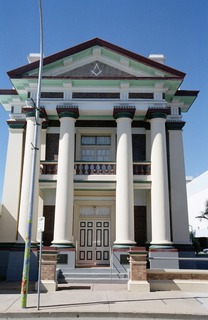
Mackay Masonic Temple is a heritage-listed masonic temple at 57 Wood Street, Mackay, Mackay Region, Queensland, Australia. It was designed by F. H. Faircloth and built in 1925 by William Ptrick Guthrie. It is also known as Masonic Hall. It was added to the Queensland Heritage Register on 14 August 2009.

Barcaldine Masonic Temple is a heritage-listed masonic temple at 39 Beech Street, Barcaldine, Barcaldine Region, Queensland, Australia. It was built in 1900. It is also known as Comet Masonic Temple. It was added to the Queensland Heritage Register on 21 October 1992.

Blackall Masonic Temple is a heritage-listed masonic temple at Hawthorn Street, Blackall, Blackall-Tambo Region, Queensland, Australia. It was built in 1908. It was added to the Queensland Heritage Register on 21 October 1992.

Charters Towers Masonic Lodge is a heritage-listed masonic temple at 20 Ryan Street, Charters Towers, Charters Towers Region, Queensland, Australia. It was built from 1887 to 1897. It was added to the Queensland Heritage Register on 21 October 1992.

Mount Perry Masonic Lodge is a heritage-listed masonic temple at Isabella Street, Mount Perry, North Burnett Region, Queensland, Australia. It was built in 1904. It was added to the Queensland Heritage Register on 21 October 1992.
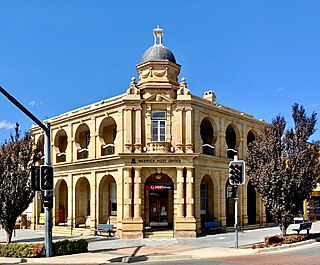
Warwick Post Office is a heritage-listed post office at 98 Palmerin Street, Warwick, Southern Downs Region, Queensland, Australia. It was designed by Queensland Government Architect Alfred Barton Brady and was built in 1898. It was added to the Australian Commonwealth Heritage List on 8 November 2011.
























